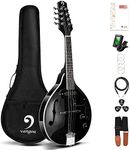Buying Guide for the Best Mandolin Instruments
Choosing the right mandolin can be a rewarding experience, whether you're a beginner or an experienced player. The key to finding the best fit for you is understanding the different specifications and how they align with your playing style, musical preferences, and personal needs. By focusing on the key specs, you can make an informed decision and select a mandolin that will bring you joy and enhance your musical journey.Body StyleThe body style of a mandolin affects its sound and playability. The two main styles are A-style and F-style. A-style mandolins have a teardrop shape and are generally simpler in design, making them more affordable and suitable for beginners or those who prefer a straightforward look. F-style mandolins have a more ornate design with a scroll and points, often preferred by bluegrass players for their distinct appearance and slightly different tonal qualities. Choose an A-style if you want a more budget-friendly option or an F-style if you are drawn to the traditional bluegrass aesthetic and sound.
Top WoodThe top wood of a mandolin significantly influences its tone. Common choices include spruce and cedar. Spruce is known for its bright, clear sound and is often used in bluegrass and folk music. Cedar, on the other hand, offers a warmer, mellower tone, which can be ideal for classical or Celtic music. If you play in a genre that requires a bright, punchy sound, go for a spruce top. If you prefer a softer, more nuanced tone, cedar might be the better choice.
Back and Sides WoodThe wood used for the back and sides of a mandolin also affects its sound. Maple is a popular choice for its bright, focused tone and strong projection, making it suitable for ensemble playing. Mahogany provides a warmer, more resonant sound, which can be great for solo performances or recording. If you play in a band or need your mandolin to cut through other instruments, maple is a good option. If you prefer a richer, more resonant sound, consider mahogany.
Neck ProfileThe neck profile of a mandolin determines how comfortable it is to play. Common profiles include V-shaped and C-shaped necks. V-shaped necks have a more pronounced ridge, which can provide a secure grip for players with larger hands. C-shaped necks are rounder and generally more comfortable for players with smaller hands or those who prefer a smoother feel. Try out different neck profiles to see which one feels most comfortable in your hand, as this will greatly affect your playing experience.
Scale LengthThe scale length of a mandolin is the distance between the nut and the bridge, affecting string tension and playability. Standard scale length is around 14 inches, providing a balance between tension and ease of play. Shorter scale lengths can make the mandolin easier to play, especially for beginners or those with smaller hands, but may result in a slightly different tone. Longer scale lengths can offer more tension and a brighter sound but may be harder to play. Choose a scale length that feels comfortable for your hand size and playing style.
FinishThe finish on a mandolin not only affects its appearance but also its sound. Common finishes include gloss and satin. Gloss finishes provide a shiny, polished look and can protect the wood better, but they may slightly dampen the instrument's resonance. Satin finishes offer a more natural look and can allow the wood to resonate more freely, potentially enhancing the sound. If you prefer a more durable and shiny appearance, go for a gloss finish. If you prioritize sound quality and a natural look, a satin finish might be the better choice.



















